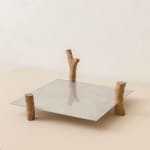





Estudio Campana
Jabuticaba tree wood and Metal
Metal Thickness: 0.08 in.
H 20.3 cm x W 47.2 cm x D 43.2 cm
Metal Thickness: 2.5 mm
Further images
This piece is a fruit bowl designed by the brothers Fernando (1961-2022) and Humberto (1953) Campana and produced
in 1990 by Estudio Campana, a pioneer of collectible disruptive design with a revolutionary language – still active nowadays.This unique piece is called "Fruteira Jabuticaba", produced in cast aluminum and jabuticaba branches – an unusual fruit tree that bears its fruit along the tree's bark. It is part of a Collection called "Orgânicos," also from 1990. In this series, the brothers experimented using cast aluminum in organic designs and added to other natural elements (branches and stones).
Fernando and Humberto Campana's investigations are crucial for understanding Brazilian design as a complex and social field. In their work, the materials play an essential role in the creative process and are also the convergence point for solid criticism of Modernist functionalism in furniture production.
The Campana pieces achieved international recognition, with worldwide awards and permanent collections in renowned cultural institutions. Centre Pompidou and the Musée Des Arts Décoratif in Paris, MoMa in New York, Museum of Modern Art of Sao Paulo, and Vitra Design Museum in Weil am Rhein, Germany, are some of the places safeguarding this legacy.





